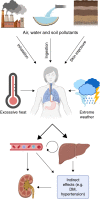Environmental Exposures and Kidney Disease
- PMID: 36591345
- PMCID: PMC9802544
- DOI: 10.34067/KID.0007962021
Environmental Exposures and Kidney Disease
Abstract
Accumulating evidence underscores the large role played by the environment in the health of communities and individuals. We review the currently known contribution of environmental exposures and pollutants on kidney disease and its associated morbidity. We review air pollutants, such as particulate matter; water pollutants, such as trace elements, per- and polyfluoroalkyl substances, and pesticides; and extreme weather events and natural disasters. We also discuss gaps in the evidence that presently relies heavily on observational studies and animal models, and propose using recently developed analytic methods to help bridge the gaps. With the expected increase in the intensity and frequency of many environmental exposures in the decades to come, an improved understanding of their potential effect on kidney disease is crucial to mitigate potential morbidity and mortality.
Keywords: air pollution; clinical nephrology; extreme weather events; kidney disease; water pollution.
Copyright © 2022 by the American Society of Nephrology.
Conflict of interest statement
N. Franceschini reports serving on the editorial boards of American Journal of Physiology–Renal Physiology and Contemporary Clinical Trials; and serving in an advisory or leadership role as a convener for the National Heart, Lung, and Blood Institute TOPMed kidney working group, as vice-chair of the Women’s Health Initiative Ancillary Committee, and on the Women’s Health Initiative Publication and Presentation Committee. A.V. Kshirsagar reports having consultancy agreements with Alkahest, Rockwell, and Target RWE; serving on the editorial boards of American Journal of Kidney Disease and Kidney Medicine; and having royalties with UpToDate (as contributor). E.M. Zeitler reports receiving research funding, via spouse, from Dexcom, Novo Nordisk, Rhythm Pharmaceuticals, and VTV Therapeutics. All remaining authors have nothing to disclose.
Figures


References
-
- Liu C, Chen R, Sera F, Vicedo-Cabrera AM, Guo Y, Tong S, Coelho MSZS, Saldiva PHN, Lavigne E, Matus P, Valdes Ortega N, Osorio Garcia S, Pascal M, Stafoggia M, Scortichini M, Hashizume M, Honda Y, Hurtado-Díaz M, Cruz J, Nunes B, Teixeira JP, Kim H, Tobias A, Íñiguez C, Forsberg B, Åström C, Ragettli MS, Guo YL, Chen BY, Bell ML, Wright CY, Scovronick N, Garland RM, Milojevic A, Kyselý J, Urban A, Orru H, Indermitte E, Jaakkola JJK, Ryti NRI, Katsouyanni K, Analitis A, Zanobetti A, Schwartz J, Chen J, Wu T, Cohen A, Gasparrini A, Kan H: ambient particulate air pollution and daily mortality in 652 cities. N Engl J Med 381: 705–715, 2019. 10.1056/NEJMoa1817364 - DOI - PMC - PubMed
-
- United States Environmental Protection Agency : Integrated science assessment (ISA) for particulate matter (final report Dec 2009), Washington, DC, United States Environmental Protection Agency, 2009. Available at: https://cfpub.epa.gov/ncea/risk/recordisplay.cfm?deid=216546. Accessed July 1, 2022 - PubMed
Publication types
MeSH terms
Substances
Grants and funding
LinkOut - more resources
Full Text Sources
Medical

